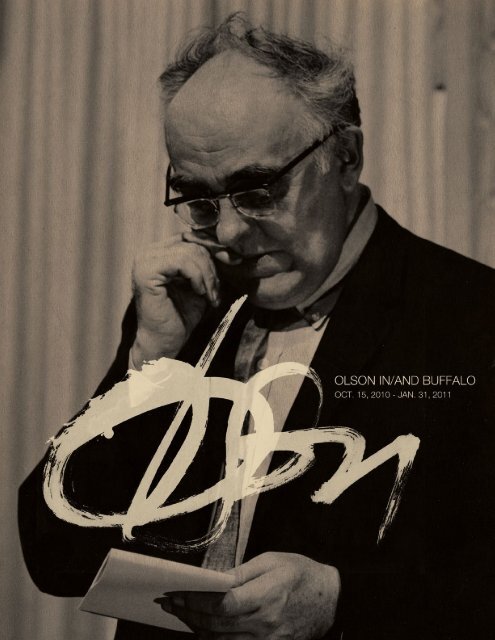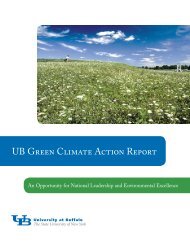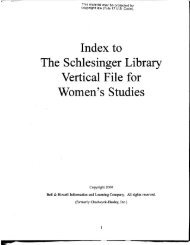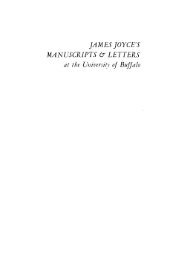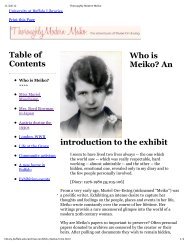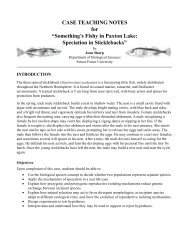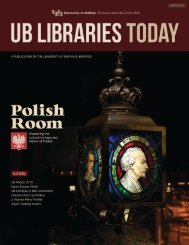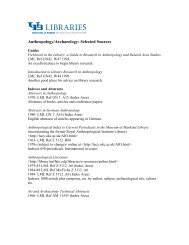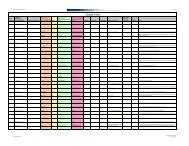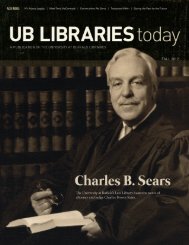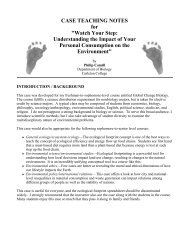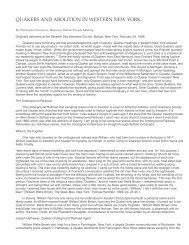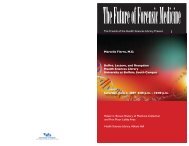Charles Olson - University at Buffalo Libraries
Charles Olson - University at Buffalo Libraries
Charles Olson - University at Buffalo Libraries
You also want an ePaper? Increase the reach of your titles
YUMPU automatically turns print PDFs into web optimized ePapers that Google loves.
The Age of <strong>Olson</strong><br />
For many American poets living <strong>at</strong> mid-century and after, <strong>Charles</strong> <strong>Olson</strong> (1910 – 1970) was a defining poet of the era, and<br />
Robert Duncan, for one, often referred to the 1950s and 1960s as “the Age of <strong>Olson</strong>.” Within the wider circle of innov<strong>at</strong>ive<br />
poetries, <strong>Olson</strong> is most closely identified with a group of writers known as the Black Mountain poets on account of their<br />
associ<strong>at</strong>ion with The Black Mountain Review, a literary magazine published by the experimental liberal arts college of the<br />
same name. <strong>Olson</strong>’s 1950 essay “Projective Verse” was a central st<strong>at</strong>ement of the group’s poetics, and he both taught <strong>at</strong> Black<br />
Mountain College and served as its rector leading up to its closing in the fall of 1956. Seven years l<strong>at</strong>er, <strong>Olson</strong> joined the UB<br />
English Department where he taught such courses as Modern Poetry and Myth and Liter<strong>at</strong>ure. Although he shortly left the<br />
department in the fall of 1965 to return to Gloucester, Massachusetts, <strong>Olson</strong> made a lasting mark on the history of poetry in<br />
<strong>Buffalo</strong> as his students edited magazines such as Niagara Frontier Review and The Magazine of Further Studies before having<br />
their own careers as poets and teachers, and to this day <strong>Olson</strong> still exists as a tutelary spirit. In addition to “Projective Verse,”<br />
<strong>Olson</strong> is best known for Call Me Ishmael (1947), a study of Melville, and especially The Maximus Poems (1953-1968), a wideranging<br />
long poem th<strong>at</strong> investig<strong>at</strong>es the history and geography of Gloucester.<br />
FIG .1<br />
Fig. 1: Divers Press edition of Mayan Letters (1953), inscribed to Robert Duncan. From Duncan’s personal library. Fig. 2: Unidentified news story fe<strong>at</strong>uring a photograph of <strong>Charles</strong><br />
<strong>Olson</strong>. From the George Butterick Collection. Fig. 3: Robert Duncan’s p<strong>at</strong>ron edition of The Maximus Poems / 11-22 (1956), one of 25 copies. From Duncan’s personal library.<br />
FIG .3<br />
FIG .2
<strong>Olson</strong> in/and <strong>Buffalo</strong><br />
<strong>Olson</strong> in/and <strong>Buffalo</strong> is an exhibition of first editions, little magazines, broadsides, manuscripts, correspondence, and<br />
ephemera th<strong>at</strong> showcases the history of <strong>Olson</strong>’s public<strong>at</strong>ions as well as the archival traces of his presence across the Poetry<br />
Collection’s various manuscript collections. The most extensive of these can be found in Jon<strong>at</strong>han Williams’s archives of the<br />
Jargon Society. Williams, a student <strong>at</strong> Black Mountain, established the eclectic Jargon Society, which, along with some of the<br />
twentieth century’s most important books of poetry, published the first two installments of <strong>Olson</strong>’s The Maximus Poems in<br />
1953 and 1956. Fe<strong>at</strong>ured in the exhibition are typescripts, page proofs, order forms, advertisements, and other production<br />
documents rel<strong>at</strong>ing to the Jargon Society’s public<strong>at</strong>ions of The Maximus Poems / 1-10 and The Maximus Poems / 11-22; letters<br />
to and from <strong>Olson</strong>; books inscribed by <strong>Olson</strong>; photographs; and other m<strong>at</strong>erials from the Jargon Collection, Robert Duncan<br />
Collection, George Butterick Collection, Jack Clarke Collection, Frontier Press Collection, Robert Kelly Collection, Athanor<br />
Collection, and Contemporary Manuscripts Collection.<br />
FIG .6<br />
FIG .4<br />
Fig. 4: Anecdotes of the L<strong>at</strong>e War (1955), along with Larry Eigner’s order form. From the Jargon Collection. Fig. 5: First typescript page of The Maximus Poems / 1-10 (1953), inscribed<br />
to Jon<strong>at</strong>han Williams. From the Jargon Collection. Reproduced with the permission of the Est<strong>at</strong>e of <strong>Charles</strong> <strong>Olson</strong>, <strong>University</strong> of Connecticut <strong>Libraries</strong>. Fig. 6: Poster for <strong>Olson</strong>’s<br />
October 4, 1963, reading <strong>at</strong> UB.<br />
FIG .5
Front: Jon<strong>at</strong>han Williams’s calligraphy design for The Maximus Poems, photograph of <strong>Charles</strong> <strong>Olson</strong> by Werner Neumeister. Reproduced with the permission of both est<strong>at</strong>es.<br />
Back: <strong>Charles</strong> <strong>Olson</strong> letter to Jack Clarke, next to a photograph of <strong>Olson</strong>’s house <strong>at</strong> 28 Fort Square, Gloucester, Massachusetts. From the Jack Clarke and George Butterick Collections.<br />
Envelope reproduced with the permission of the Est<strong>at</strong>e of <strong>Charles</strong> <strong>Olson</strong>, <strong>University</strong> of Connecticut <strong>Libraries</strong>.<br />
The Poetry Collection of the <strong>University</strong> <strong>Libraries</strong> is the library of record for 20 th - and 21 st -century poetry in English. Founded<br />
more than 70 years ago, the Poetry Collection now holds the world’s largest collection of poetry first editions, little literary<br />
magazines, broadsides, anthologies, criticism, ephemera, and audio recordings, as well as over 150 manuscript collections<br />
from a wide range of presses, magazines, arts organiz<strong>at</strong>ions, and writers such as James Joyce, William Carlos Williams, and<br />
Robert Graves. Also fe<strong>at</strong>ured in the Collection are the personal libraries of poets such as Helen Adam and Robert Duncan;<br />
artworks by Salvador Dali, Constantin Brancusi, Jess (Collins), Wyndham Lewis, and E. E. Cummings; and substantial<br />
collections of mail art, visual and concrete poetry, photographs, and zines. An active research center for the study of all facets<br />
of modern and contemporary poetry, each year the Collection welcomes dozens of scholars and gradu<strong>at</strong>e students engaged<br />
in primary research; assists with educ<strong>at</strong>ional activities; hosts numerous readings, lectures, and other events; and loans items<br />
to exhibitions around the world.<br />
Gifts of books, manuscripts, and archival m<strong>at</strong>erials significantly contribute to the excellence of the Poetry Collection. For<br />
inform<strong>at</strong>ion about don<strong>at</strong>ing m<strong>at</strong>erials to the Poetry Collection, please contact lpo-poetry@buffalo.edu or call (716) 645-2917.<br />
Monetary gifts support the acquisition, organiz<strong>at</strong>ion, preserv<strong>at</strong>ion, digitiz<strong>at</strong>ion, and exhibition of books, magazines, and<br />
literary archives. Don<strong>at</strong>ions to the Poetry Collection General Fund can be made online <strong>at</strong> library.buffalo.edu/support.<br />
On display from October 15, 2010 through January 31, 2011, <strong>Olson</strong> in/and <strong>Buffalo</strong> is cur<strong>at</strong>ed by Alice Bailey, Jeannie Hoag,<br />
Simon Horning, Mary E. Kohler, Susan A. Sturm, James Maynard, and Michael Basinski.<br />
Funding for the exhibition has generously been provided by Joan and Louis Slovinsky.<br />
The Poetry Collection 420 Capen Hall, <strong>Buffalo</strong>, NY 14260-1674<br />
(716) 645-2917 | library.buffalo.edu/pl


